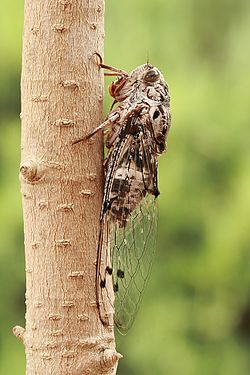Cicada
Cicadas are small insects. They are kinds of true bugs.
| Cicada | |
|---|---|

| |
| Floury baker, Abricta curvicosta | |
| Scientific classification | |
| Kingdom: | |
| Phylum: | |
| Class: | |
| Order: | |
| Infraorder: | |
| Family: | Cicadidae
|

The noisy buzz they make is the male calling to the female using his vibrating panels, called tymbals, on his sides. When the female, who cannot buzz, hears the buzz of a male, she searches for him. After they mate, the female will use her ovipositor to cut a line into the branch of a tree and lay her eggs there. Adult cicadas don't usually bite. They are usually green or black. Cicadas can also be eaten. It is eaten in countries like China.
Cicadas live in temperate to tropical climates where their large size and unique sound makes them well known. Cicadas are often colloquially called locusts,[1] although they are unrelated to true locusts, which are a kind of grasshopper. Cicadas are related to leafhoppers and spittlebugs.
Taxonomy
Cicadas are arranged into two families: Tettigarctidae and Cicadidae.[2] There are two living species of Tettigarctidae, one in southern Australia, and the other in Tasmania.
The family Cicadidae is very widespread.[2] They live on all continents except Antarctica. The largest cicadas are in the genera Pomponia and Tacua. There are some 200 species in 38 genera in Australia, about 450 in Africa, about 100 in the Palaearctic, and exactly one species in England, the New Forest cicada, Melampsalta montana, widely distributed throughout Europe. There are about 150 species in South Africa.
Most of the North American species are in the genus Tibicen: the annual or jar fly or dog-day cicadas (so named because they emerge in late July and August). [1]
Periodic cicadas
The best-known North American genus is Magicicada. These periodical cicadas have an extremely long life cycle of 13 to 17 years and then emerge in large numbers.[1] The advantage of this arrangement is that the predators are swamped by their numbers, and so most of them survive. There are three species of 17-year periodical cicadas.[3]
Australian cicadas
Australian cicadas differ from many other types because of that continent's diversity of climate and terrain. In Australia, cicadas are found on tropical islands and cold coastal beaches around Tasmania; in tropical wetlands; high and low deserts; alpine areas of New South Wales and Victoria; large cities like Sydney, Melbourne, and Brisbane; and Tasmanian highlands and snowfields.
Forty-two species from five genera populate New Zealand, and all are endemic to New Zealand and the surrounding islands (Norfolk Island, New Caledonia).[4] Many New Zealand cicada species differ from those of other countries by living high up on mountain tops.
Cicada Media
A chorus cicada, a species endemic to New Zealand
cicada in Japan
Mesozoic fossil fore wing of Mesogereon superbum, Australia
The giant cicada Prolystra lithographica from Germany Jurassic, about 145–150 million years ago
Head of Magicicada septendecim showing red eyes and ocelli
A Japanese Min-min-zemi, called with onomatopoeia (Hyalessa maculaticollis, annual cicada)
A Japanese Nii-nii-zemi (ニイニイゼミ), called with onomatopoeia (Platypleura kaempferi, annual cicada)
A black cicada just after molting in the garden of a private house (Midwest Saitama Prefecture, Japan)
References
- ↑ 1.0 1.1 1.2 Milne, Lorus; Milne, Margery (1992). The Audubon Society field guide to North American insects and spiders. New York: Alfred A Knopf. ISBN 0-394-50763-0.
- ↑ 2.0 2.1 Moulds M.S. 2005 (2005). "An appraisal of the higher classification of cicadas (Hemiptera: Cicadoidea) with special reference to the Australian fauna" (PDF). Records of the Australian Museum. 57 (3): 375–446. doi:10.3853/j.0067-1975.57.2005.1447. Archived from the original (PDF) on 2011-11-05. Retrieved 2012-03-27.
- ↑ Lloyd M. 1984. Periodical cicadas. Antenna 8: 79-91.
- ↑ Taonga, New Zealand Ministry for Culture and Heritage Te Manatu. "1. – Cicadas – Te Ara Encyclopedia of New Zealand". teara.govt.nz.[dead link]








